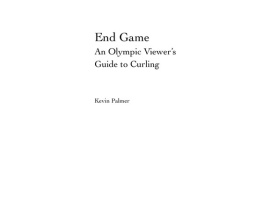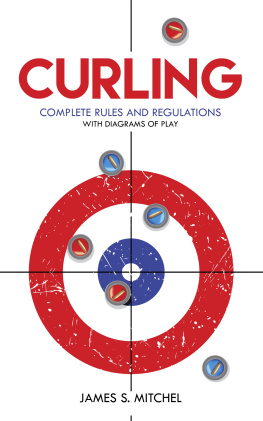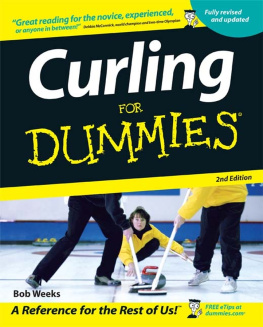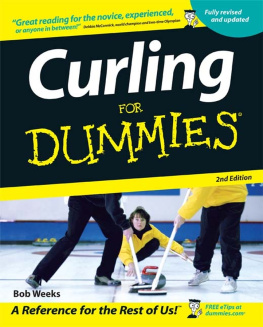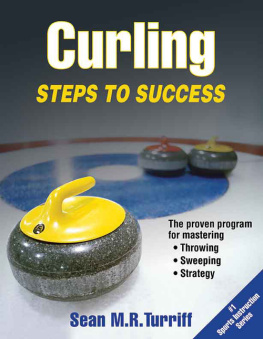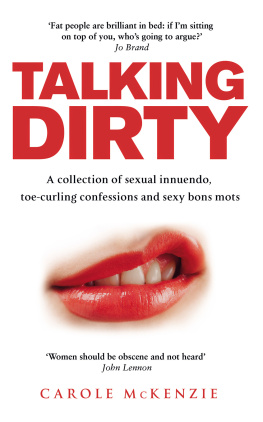End Game: An Olympic Viewer's Guide to Curling
Kevin Palmer
Copyright 2014 by Kevin Palmer
Smashwords Edition
A Brief History
The purpose of this book is to make you a better armchair skip, not a curling historian. However, with even a limited knowledge of curling history, you can beguile and amuse your friends with tidbits of curling folklore that will impress them and make you the most admired of your peers. Detailed historical texts on Curling can be obtained from your local curling book shop, the internet, or from scouring the archives of the Canadian Curling Association and the Royal Caledonian Club in Scotland. I've included a list of suggested reading in Chapter 10. For now, we will simply brush the frost off the surface of curling history, so that you may be smarter than the average fan. Disclaimer: In most cases I have attempted to be historically accurate. In other instances, I have not. I suggest when repeating these facts to others, act confident and do not budge when challenged. I have found that being wrong, but decisive and unwavering, is often more effective than being correct.
Dramatic changes to the game, ice conditions, synthetic brooms, and free guard zone allow us to, if we choose, completely forgot anything before 1993. Curling pre-O.J. has little resemblance to the sport it is today. However, it is interesting to understand where the origins of ideas and concepts came from, and trace the modern game back to its roots. Canada didn't adopt a four rock free guard zone until several years after the rest of the World, but those pesky Canucks kept on winning championships and dominating regardless of the rules and conditions. To those non-Canadians who are reading this, I apologize in advance for a chapter that is heavily weighted with Canadian curling history. Having lived in the Great White North my entire life, it's much easier for me to make things up about curling in Canada than anywhere else.
Pre 1930
Do we really have to talk about this era? Were any of you even around? How often does Vin Scully harken back to the good old days of baseball in the 1860s? Hardly ever. Jim Nantz never waxes poetic on the feathery or the niblick when discussing a shot to be played by Tiger Woods.
There was curling. Originally played outdoors on a frozen body of water, it moved indoors. It was still cold. Brooms (originally household variety) were introduced in the early twentieth century. Players dressed in suits and ties because, like golfers of the era, it was more important to look sharp than to be comfortable. At some point the wool sweater was introduced and the game flourished. Few people know that bad Christmas sweaters were first invented by curler's wives, ensuring their husbands weren't snatched up by curling flappers, trolling about the rinks of the jazz era.
Early Years: Canada
Curling was brought to Canada from Scotland and, without an abundance of proper granite, cannonballs were originally melted to make curling "stones". In fact, iron stones continued to be used in Quebec up until about 1955. The first Canadian curling club was formed in Montreal in 1807. This early adoption of the game did not lead to success however, Quebec has only won the Canadian Championship twice, Jim Ursel in 1977 and Jean-Michel Menard in 2006. It does, however, have poutine, maple syrup and beautiful women.
The Brier
In 1924 the President of MacDonald Tobacco, George J. Cameron, pitched his company on the idea to host a Canadian Curling Championship. Despite the failings of their recent synchronized swimming nationals, the board agreed and a plan was set in motion. In 1927 the first Brier was played and the Murray Macneill rink from Nova Scotia won the event, held in Toronto. In fact, 14 of the first 15 Briers were held in Toronto, but none since 1941. Possibly Leafs fans don't want anything to distract them from their historic legacy of incompetence. Nova Scotia failed to properly market Murray's inaugural win with local maritime youth and would not win another Brier until 1951 with a third for the Bluenosers coming 53 years later, in 2004. For those unfamiliar, Nova Scotia people do not actually have blue noses but are called this because of a grumpy preacher from the late 1700s.
The name Canadian National Curling Championship seemed fitting but clearly too long to pronounce after consuming more than 13 rye and sarsaparillas, so it was named the Brier for short. The term Brier came from a brand of tobacco manufactured by MacDonald at the time. According to wikipedia, a brier is a small shrub whose roots are commonly used to make tobacco pipes. No reason for us to argue with wikipedia. The patch adorned by competitors, the Purple Heart, is also designed from popular Macdonald products. Much of the cancer in Canada's future can be traced to the success of Macdonald Tobacco's Brier marketing team.
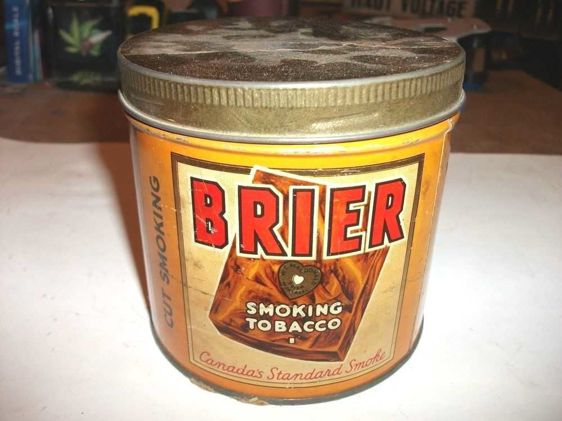
Brier Tobacco. A free can for every curling fan
Early Years: Europe
Curling spread across the continent like a war, or massive flu epidemic. No, wait, my mistake. War spread across the continent and brought a massive flu epidemic and curling was in no way responsible.
The Royal Caledonian Curling Club (RCCC, also known as the Mother Club) was founded in 1838 in Edinburgh, Scotland. It has branches and affiliate clubs around the world, most of which were not established by British colonial rule. The Grand Match was a historic bonspiel begun in 1846 and held most recently outdoors on the Lake of Menteith in Stirling, Scotland when the weather was cold enough. It was a match between the North and South of Scotland attracting thousands of curlers. Only 3 matches were held between 1945 and 1979 (the last one). In December 2010, unreasonably cold weather had everyone speculating the match would take place, but plans were scrapped due to health and safety (i.e. liability) issues.
Curling was first played in Sweden in 1847 and established a national association in 1916, with a Swedish Championship first held in 1917.
In 1924, the year curling was included in the first Winter Olympic games, Switzerland had 25 clubs affiliated with the RCCC. However, they did not yet have a national association and failed to show for the Olympics despite being invited. The French (hosting the games) also had no national governing body, but participated with members from the RCCC affiliated Chamonix (Mont Blanc) Curling Club.
Early Years: USA
The first curling club in the United States was the Orchard Lake Curling Club, organized in 1831 roughly 30 miles from Detroit. The club used hickory block "stones". Care had to be made to keep the beavers from gnawing off the handles. A Detroit Curling Club began in 1840 and then, in 1885 The Detroit Curling Club was formed. Eventually, the automobile was invented and many curlers decided that driving south for a winter vacation was a better choice than tossing wood chunks along a frozen lake.
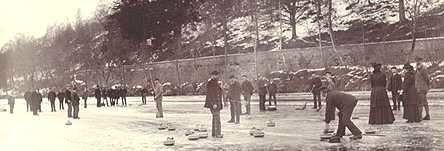
Motown records can trace it's roots back to curling on the Detroit River before the turn of the century
The St. Paul Curling Club in Minnesota was established in 1885. The first curling club established in Duluth was 1891. According to the local paper the first game played Christmas forenoon (before noon, or shortly after presents were opened). Duluth would eventually host two World Championships, the US Olympic Trials and countless other events. Nearby Hibbing Curling Club started in 1913. The Bemidji Curling Club started in 1935 and its members have won over 50 state and national titles. The Duluth and Hibbing clubs are sour and resentful over Bemidji's success and continue to plot and scheme so that one day, they will rule the curling world in Minnesota.
Next page
